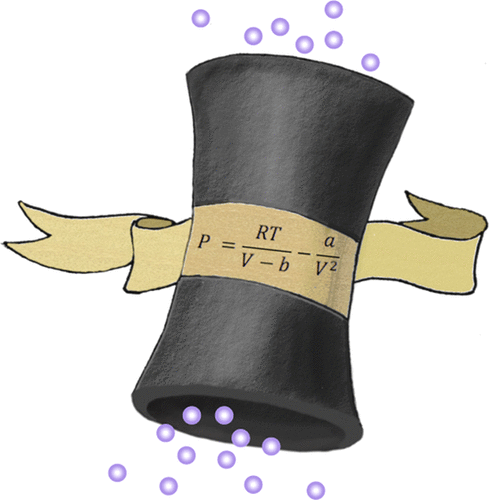当前位置:
X-MOL 学术
›
Ind. Eng. Chem. Res.
›
论文详情
Our official English website, www.x-mol.net, welcomes your feedback! (Note: you will need to create a separate account there.)
Compressibility of a Simple Fluid in Cylindrical Confinement: Molecular Simulation and Equation of State Modeling
Industrial & Engineering Chemistry Research ( IF 4.2 ) Pub Date : 2020-04-15 , DOI: 10.1021/acs.iecr.0c00693 Christopher D. Dobrzanski 1 , Nicholas J. Corrente 1 , Gennady Y. Gor 1
Industrial & Engineering Chemistry Research ( IF 4.2 ) Pub Date : 2020-04-15 , DOI: 10.1021/acs.iecr.0c00693 Christopher D. Dobrzanski 1 , Nicholas J. Corrente 1 , Gennady Y. Gor 1
Affiliation

|
Fluids confined in nanoporous materials exhibit thermodynamic properties that differ from the same fluid in bulk. Recent experiments and molecular simulations suggested that the isothermal compressibility is among these properties. The compressibility determines the elastic response of a fluid to mechanical impact, and in particular, the speed of acoustic wave propagation through it. Knowledge of the compressibility of fluids confined in nanopores is needed for understanding the elastic wave propagation in fluid-saturated nanoporous media, such as hydrocarbon-bearing shales. Molecular simulations allow for the prediction of the elastic properties of a confined fluid but require computationally expensive calculations for each system and pore size. Therefore, there is interest for a more straightforward model that can predict the elastic properties of a confined fluid as a function of the external pressure and confining pore size. Such models can be based on an equation of state (EOS) for a confined system. Here, we explore a possibility for a generalized van der Waals EOS for confined fluids to predict the compressibility. We also calculate the elastic properties of argon confined in silica nanopores from grand canonical Monte Carlo simulations. We obtain comparable adsorption isotherm predictions of the EOS and simulations at various pore sizes and temperatures without changing any other parameters. We then see how the predictions of the elastic properties from simulations compare to the EOS and find reasonable agreement. Additionally, we vary the solid–fluid interaction parameters in both the EOS and molecular simulations to represent solids other than silica and see how the elastic moduli depend on the other properties of confining pores related to the interaction strength. This work is a step toward a quantitative description of wave propagation in fluid-saturated nanoporous media.
中文翻译:

圆柱约束中简单流体的可压缩性:分子模拟和状态方程
限制在纳米多孔材料中的流体表现出的热力学特性不同于相同的本体流体。最近的实验和分子模拟表明,等温压缩性是这些特性之一。可压缩性决定了流体对机械冲击的弹性响应,尤其是声波在其中传播的速度。需要了解封闭在纳米孔中的流体的可压缩性,以了解在流体饱和的纳米多孔介质(例如含烃页岩)中的弹性波传播。分子模拟可以预测承压流体的弹性,但需要为每个系统和孔径计算昂贵的计算。因此,人们希望有一个更直接的模型,该模型可以预测承压流体的弹性特性,作为外部压力和承压孔径的函数。此类模型可以基于密闭系统的状态方程(EOS)。在这里,我们探索了用于密闭流体的广义范德华EOS预测可压缩性的可能性。我们还通过经典的蒙特卡洛模拟计算了局限在二氧化硅纳米孔中的氩气的弹性。我们在不改变任何其他参数的情况下,获得了可比的EOS吸附等温线预测和在各种孔径和温度下的模拟。然后,我们将看到模拟中的弹性特性预测与EOS的比较,并找到合理的一致性。另外,我们在EOS和分子模拟中都改变了固液相互作用参数,以表示除二氧化硅以外的固体,并观察了弹性模量如何取决于与相互作用强度有关的封闭孔隙的其他特性。这项工作是迈向定量描述流体饱和纳米多孔介质中波传播的一步。
更新日期:2020-04-24
中文翻译:

圆柱约束中简单流体的可压缩性:分子模拟和状态方程
限制在纳米多孔材料中的流体表现出的热力学特性不同于相同的本体流体。最近的实验和分子模拟表明,等温压缩性是这些特性之一。可压缩性决定了流体对机械冲击的弹性响应,尤其是声波在其中传播的速度。需要了解封闭在纳米孔中的流体的可压缩性,以了解在流体饱和的纳米多孔介质(例如含烃页岩)中的弹性波传播。分子模拟可以预测承压流体的弹性,但需要为每个系统和孔径计算昂贵的计算。因此,人们希望有一个更直接的模型,该模型可以预测承压流体的弹性特性,作为外部压力和承压孔径的函数。此类模型可以基于密闭系统的状态方程(EOS)。在这里,我们探索了用于密闭流体的广义范德华EOS预测可压缩性的可能性。我们还通过经典的蒙特卡洛模拟计算了局限在二氧化硅纳米孔中的氩气的弹性。我们在不改变任何其他参数的情况下,获得了可比的EOS吸附等温线预测和在各种孔径和温度下的模拟。然后,我们将看到模拟中的弹性特性预测与EOS的比较,并找到合理的一致性。另外,我们在EOS和分子模拟中都改变了固液相互作用参数,以表示除二氧化硅以外的固体,并观察了弹性模量如何取决于与相互作用强度有关的封闭孔隙的其他特性。这项工作是迈向定量描述流体饱和纳米多孔介质中波传播的一步。


























 京公网安备 11010802027423号
京公网安备 11010802027423号